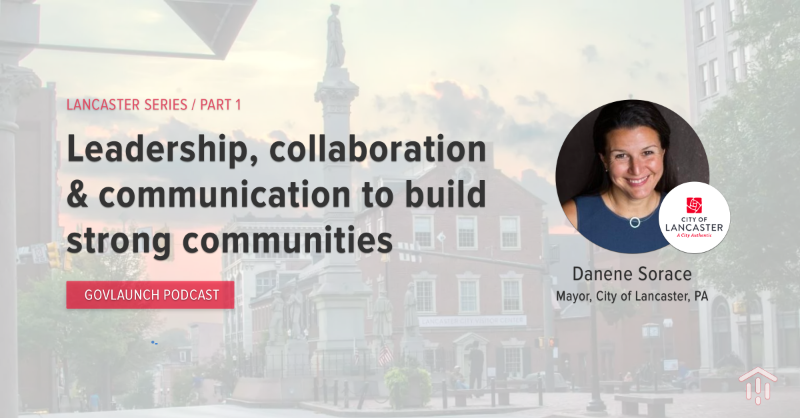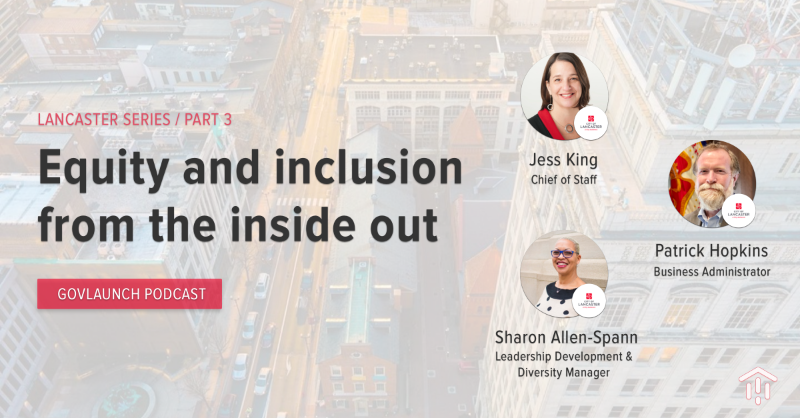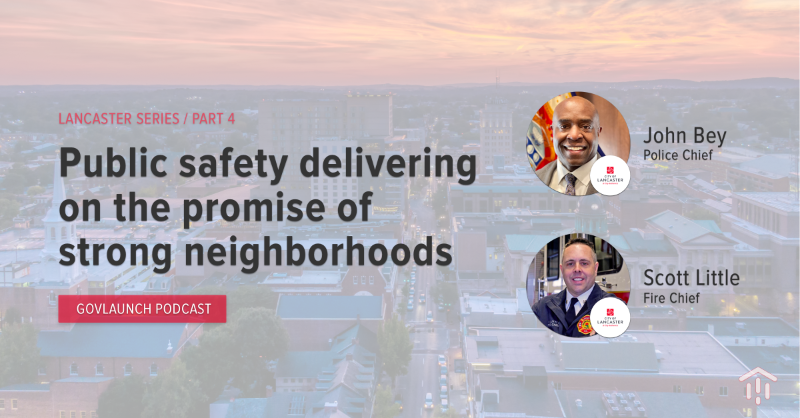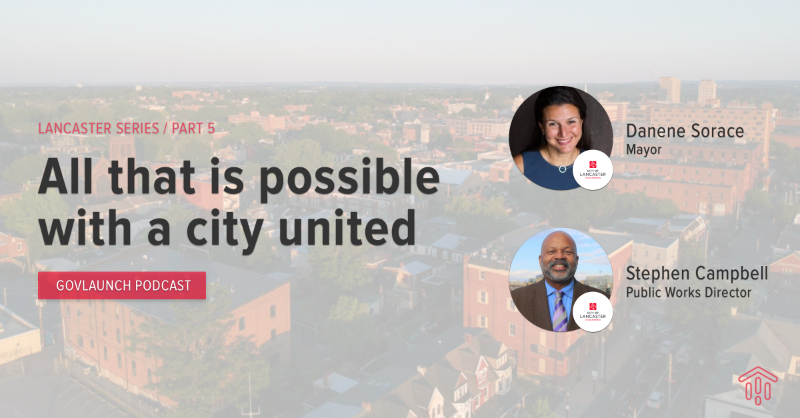5 Lessons from Lancaster’s fresh spin on local government
Through its focus on equity, collaborative teams, and community engagement, Lancaster has emerged as a leader in local government management.
Zusammenfassung
As one of the oldest inland cities in the United States, $ Lancaster, PA$ , is steeped in history. Set among the farmlands of Pennsylvania Dutch Country, the city is known for Amish traditions, President James Buchanan’s nearby estate, and a downtown core that includes a nearly 300-year-old farmer’s market.
But there’s a current of change running through this 60,000–person community. A vibrant arts scene has taken root. Old industrial buildings are being transformed into restaurants, breweries, design studios, and housing. The population is shifting, growing more diverse.
And in 2018 a new leader took the helm of the city’s government, bringing with her a new vision and fresh way of working across the organization.
$ Mayor Danene Sorace$ — the second woman to hold the position here — was elected on a promise to build strong neighborhoods and promote equity in Lancaster. To do so, she has reimagined how local government works and serves the public, from breaking down departmental silos to pushing for a more representative hiring process, to introducing services designed to bolster community engagement.
In this deep dive on Lancaster’s innovative approach to local government, we’re exploring what it looks like when a city reorganizes its leadership structure and puts an emphasis on equity, communication and collaboration. Through conversations with Mayor Sorace and her team, we’ve uncovered 5 major lessons that cities of any size can learn from Lancaster:
- How to change the culture of local government to promote equity and innovation
- How to drive engagement with your citizens and within local government
- How to create a more equitable community internally and externally
- How collaborative leadership leads to safer, more engaged cities
- How to break down silos and create a unified vision
Let’s take a closer look at what’s going on in Lancaster.
Lesson 1: How to change the culture of local government to promote equity and innovation

Advice from Mayor Danene Sorace
Government is not inherently set up to be entirely equitable. When Danene Sorace became mayor of Lancaster, she set out to address this head on:
“My approach to civic leadership is really rooted in service and it’s focused on ensuring the greatest good with a special emphasis on equity.”
A big part of her focus was on creating strong neighborhoods, looking at how to serve citizens on a block by block level. To do this, Mayor Sorace had to take an already highly functioning local government, and layer in new priorities and ways of working. New leadership roles were added. Transparency was championed, through open data and lots of communication. Citizens were brought into the process, through digital tools like a new engagement portal, and by good old fashioned door-knocking. Over time, Lancaster became a place where departments work collaboratively, data is shared and used to drive decisions, and policies are more inclusive.
But it wasn’t always smooth sailing. Listen to the full episode to hear how Mayor Sorace navigated the challenges that come with changing a legacy culture.
Key Takeaways
Use data to foster open conversations
Not only is data a powerful decision making tool, it can also be the bridge to bringing departments together in local government. As part of its neighborhoods initiative, Lancaster partnered with $ Tolemi$ to develop a block strength indicator, which looks at data on an individual block level.
By viewing various datapoints around this one block together, different departments were able to come together and attack challenges as a team:
“That became a way for us to bring different people to the table and have a conversation about what the block strength indicator is... We are thinking about these things more holistically rather than a sort of whack-a-mole approach.”
Transparency requires honesty
Part of being transparent and engaging with your community is being honest about what can and can’t be done. In Lancaster, the more Mayor Sorace’s team engaged with citizens, the more she came to realize how little residents understood what local government’s role was. What’s more, many never bothered to engage with their government because they assumed nothing would ever come of it.
Rather than attempting to solve every problem raised by citizens, Mayor Sorace says the goal is to listen to people, and respond to them, even if the response may lead to disappointment:
“Being responsive also comes with a dose of reality and honesty about some of the things we can fix and some of the things we can’t, but it means that we are following up and being responsive. We are helping people believe and know that local government is here to serve them.”
Learn from others
One of the new positions Mayor Sorace added to her leadership team was a Director of Neighborhood Engagement. It’s a key role that’s deeply tied to the city’s priorities and unique needs. But the idea isn’t new to Lancaster.
“I stole this idea directly from New Orleans. I found their office of neighborhood engagement and found their job description. I changed it to reflect what we needed here in Lancaster and we ran with it and it’s been a game changer.”
It’s often the case that another city or county is facing similar challenges, and there’s no need to reinvent the wheel by ideating a solution from scratch. Instead, look at what others have tried, and make adjustments to meet your local government’s needs.
Lesson 2: How to drive engagement with your citizens and within local government

Advice from Milzy Carrasco, Director of Neighborhood Engagement, and Chris Delfs, Director of Community Planning and Economic Development
Often when we talk about community engagement, we focus on how local governments communicate with citizens, and bring them into the governing process. In Lancaster, as part of the push to create strong neighborhoods, the city introduced a new department devoted to making this happen. Milzy Carrasco, who heads up the city’s neighborhood engagement efforts explains:
“Local government is very service oriented, and sometimes you just need a liaison to connect some of the residents and the partners from the outside internally to some of our project managers.”
But what stands out about Carrasco’s team is that they aren’t just looking outward. They’ve also become an internal resource for all parts of Lancaster’s government, to better equip teams to work with the public, to pursue more accessibility and representation in how the government functions, and to create engagement between the different city agencies.
This focus on all-around engagement has paid off across an array of projects — for more details on these, check out the full podcast episode above.
Featured Projects
Engage Lancaster
A major step in the city’s drive for open communication was the launch of $ Engage Lancaster$ , a digital engagement platform set up in partnership with $ CitzenLab$ . City project managers and teams can engage the public to get feedback on specific initiatives, like a survey on housing and community development that Chris Delfs team put out:
“We use the Engage Lancaster online platform to try to determine what are the priorities of our residents or that five years of [HUD] funding, particularly for housing and community development related solutions. And we went from getting almost no comments the last few years to 322 responses through the online survey.”
By creating a tool that’s easy for the public to use, and making it accessible to various departments looking for community input, Lancaster has created a foundation of citizen engagement that can be broadly applied.
Love Your Block
One of the best ways to promote sustainable engagement is to change residents’ habits and give them some ownership of the changes to the community.
To do this, Lancaster launched “$ Love Your Block$ ,” in partnership with $ Bloomberg Philanthropies$ and $ Cities of Service$ . This program trains neighborhood leaders, showing them how to identify issues in their communities and how to develop solutions (including funding) to fix them. Not only did the program create a lot of leadership within the community, says Carrasco, it allowed the city to do a deep dive into what the community wanted:
“That really was the foundation of understanding what residents' needs were because we really actually built the program by canvassing and asking residents what their needs were. And so through canvassing and speaking to residents, we identified that people wanted to fix their neighborhoods, but really didn't have access or the know-how or the funds to do so. And they wanted to know their neighbors, engage with their neighbors in projects, but didn't know how to do that.”
Lancaster’s Comprehensive Plan
Most cities and counties have a comprehensive plan; they’re essentially a long term (say, 20 years) vision for a community. Lancaster’s plan was overdue for an overhaul — the last one was updated in 1993.
When creating a comprehensive plan, it’s normal to convene a committee of community representatives to weigh in on the proposed plan. But, thanks to its community engagement prioritization and framework, Lancaster did things a little differently, says Delfs:
“The part that I think is so creative is the fact that we were able to create the comprehensive plan committee early in the process before the project got launched. And we have involved them in both the scoping of the process and ultimately in the selection of our consultant team, who will be managing the project.”
This approach created buy-in from the start, and resulted in a more collaborative planning process, which will have long term benefits for Lancaster, says Delfs:
“If we think about sustainable and equitable development, we need all of these stakeholders as part of this comprehensive plan, which will shape the economic development of the city for generations to come.”
Lesson 3: How to create a more equitable community internally and externally

Advice from Jess King, Chief of Staff; Patrick Hopkins, City Business Administrator; Sharon Allen-Span, Leadership Development and Diversity Manager
Local government exists to serve the public, but sometimes the people in local government lose sight of who these people actually are. City Chief of Staff Jess King admits that this was happening in Lancaster:
“It’s a city that has a majority of people of color. And a lot of people, I think, who worked for the city or others, maybe who've been in the city, don't know that. Don't know how demographics have changed over time and aren't necessarily thinking about the city in its true character and who we are as a community.”
But understanding who Lancaster is as a community is vital to representing this community, says King:
“I feel like it's really important to keep centering ourselves in that. And to remember as public servants, we work for the city, we work for the residents who live here, pay us, who pay their taxes in different ways and essentially fund our salaries.”
This focus on local government being reflective of the community, and creating equity, has become a cornerstone of the city’s policies. It’s led to innovations in how Lancaster hires city workers. How projects are structured and how utilities are billed. How the government talks to the public.
Listen to the full episode for a deep dive into the policies and projects Lancaster is embracing, and the impact the city is seeing as a result.
Key Takeaways
Start with the work you’re already doing
No one in local government has extra time on their hands. It’s hard to add new projects to any team’s plate, so sometimes adding new priorities or initiatives can feel like a daunting task.
But promoting equity and inclusion does not have to be a net new undertaking. It can (and should) be woven into the work that agencies are already doing. In fact, the work will have more impact if applied to existing areas of government and existing decision-making, says Sharon Allen-Span, Leadership Development and Diversity Manager:
“Diversity, equity and inclusion work is not new. This is the work, and it's really about how do we embed it in what we're already doing, because there's no way that the average employee can add a new task. It's asking: can I refine the task, if I can think about what questions do I ask myself when I'm making my decisions... that's how we get to build equity without it overwhelming the system.”
It’s not just what you say… it’s how you say it
There’s so much emphasis on ways local governments can connect with their citizens — social media, digital engagement platforms, community events, you name it. But in Lancaster, the focus isn’t just on tactics to get in touch with the public. It’s on making sure the language used is actually going to resonate.
A large percentage of the local population here speaks Spanish, and it’s estimated that over 50 languages are spoken by students in the Lancaster school district. Lancaster officials realized that if they want to engage with these parts of the community, the standard language, and ways of connecting, might not cut it, says Patrick Hopkins, City Business Administrator:
“It's not enough simply to say, well, we had a public meeting and nobody showed up. If we're not inviting residents to those public meetings, or to the Engage Lancaster platform, or, you know, some of the other resources we have to engage our public and also helping to bridge that communication gap between city staff or some of our partners and our residents whose first language might not be English, we're not really providing services to all of our residents.”
To address the language gaps, Lancaster created a “language line.” All city workers have a card with access to this line. If a resident calls in or walks into City Hall looking for services, but English isn’t their first language, the city staffers can connect with a translator over the phone to better assist. Says Hopkins:
“It just makes for a much more comfortable engagement between city staff and the resident. The resident can feel much more comfortable in their native language talking about the issue that they may be bringing or question that they may have. And so that language line has really bridged the gap.”
Be intentional
It’s easy to talk about how you’re working to be a more equitable organization. But it’s time for local governments to walk the walk. In Lancaster, that means being very deliberate about how the choices made by government departments align with equity goals and representing the whole community.
Take hiring, for example. Lancaster is putting a lot of thought into how to build a local government workforce that is reflective of the community itself. This includes being more deliberate about whether job postings are written in understandable language, and if they’re attracting candidates that represent the demographics of the city, says Allen-Span:
“There's so much about how we show up as a city, as an employer, as a team of employees with over 500 employees to really influence this conversation and live it out, not just have it be words on a page or ideals, but like how do we embed this in culture and in teamwork and in hiring and practices to make sure that it actually means something, it makes a difference at the end of the day.”
Just start somewhere (and iterate)
Fear of failure is the death of innovation. Once you’ve identified a problem, pick a solution and test it out. If it doesn’t work, or if it works but doesn’t completely solve the issue, you can evolve your approach from there.
In Lancaster, there’s still a lot of work to be done when it comes to a language program. Documents need to be translated, services and applications need to be re-introduced with comprehensible instructions. But rather than spinning on a massive language solution, the city started somewhere: the language line that connects all workers to a translator. Seeing success there, Lancaster can now expand the approach to other areas. The key, notes Hopkins, is to try:
“There are things that aren't going to work, you will fail periodically and that's okay. But if you start somewhere on an issue where you know that the city government, the local government can actually make a difference, you're going to start solving problems and then you can iterate from there to solve more.”
Lesson 4: How collaborative leadership leads to safer, more engaged cities

Advice from Police Chief John Bey and Fire Chief Scott Little
If you run a police department, there’s plenty of police business to focus on. Same goes for a fire department. So it’s unusual that if you run a police department you’re also thinking about fire needs, or if you lead fire, that you’re hands-on in policing. But in Lancaster, Police Chief John Bey and Fire Chief Scott Little are very involved in the other’s work. Chief Little explains:
“We have really been breaking down some of those decade-old silos that promoted a police vs. fire mentality. We've been able to build our teams and our mid-level managers and our supervisors to really see the big picture of a city, not just our public safety entities.”
In Lancaster, this sort of cross-departmental partnership among leaders is now the norm — not just within public safety, but across city agencies. The result is a more holistic view of the community’s needs and challenges, stronger engagement between city leaders and the public, and a unified plan of attack for how the local government can serve its citizens.
Listen to the full episode above for a lesson in leadership from Lancaster’s two leading public safety voices.
Key Projects
Walking audits
Lancaster’s open data program has made a huge impact on the city’s ability to identify and fix problems. But sometimes you just can’t beat an old fashioned stroll.
City department leads do just that on their “walking audits,” where leaders from various parts of the government come together and walk around various neighborhoods. Fire Chief Little explains:
“All the department directors are out walking the block together, identifying the needs and how each department and bureau hsa a part to play in fixing that block, or what we can do with our staffs to make sure it’s improved.”
It’s a simple activity, but one with many benefits: not only do neighborhood issues get examined through multiple lenses and areas of expertise, but the collaborative walks foster teamwork between the departments, and help pave the way for more cooperation off the streets.
Publicized policies
One of the pillars of Mayor Sorace’s government is transparency, and the police and fire departments in Lancaster are living by this rule. Says Fire Chief Little:
“We're open and honest and transparent with all of our processes. We're seeing that in the police bureau, where they have now put all their policies online. Any resident can refer to the police website and see, Here's our policy of how we conduct day-to-day business. Fire, we're the same way — we're open about everything we have to offer to our residents, because we are the public safety personnel for the city as taxpayers. They deserve to really have that open book into how we're spending taxpayer dollars.”
The police department also posts updates on their overall statistics, including arrests, use of force, and other data. Police Chief John Bey says this information sharing is an important part of community engagement:
“It's important for that information to be shared, and that people know that it is truly a partnership between the police department and our community.”
Community engagement
Sharing statistics is one of many ways the police and fire departments are fostering community ties with their departments. Other initiatives, like bike patrols and open fire stations, are also encouraging public safety officers to become more involved in the neighborhoods they’re serving.
Both Chiefs stress that it’s important to be intentional about your engagement with community. According to Chief Bey:
“Be very intentional about non-enforcement engagement with your community from a police perspective. It goes back to old school police officers walking the beat, stopping into corner stores, removing themselves from that, what I call “mobile barrier,” which is their patrol car and just getting out, interacting with folks and letting them meet and get to know that person inside the uniform. [They learn] that person is a father or mother or brother, a sister, a wife, a husband, you know, just normal people who have a job to do. This develops that authentic organic relationship with your communities.”
Chief Little agrees, it’s all about connecting:
“What goes in hand in hand with breaking down the silos is the more you build relationships and network with people, you can immediately have responses and interactions and you can get more work done for our community when they call and need assistance.”
Lesson 5: How to break down silos and create a unified vision

Advice from Mayor Danene Sorace and Stephen Campbell, Director of Public Works
In order to have every municipal department working together toward a common goal, you need to define that goal. In Lancaster, the vision is clear, says Mayor Sorace:
“The vision for the city of Lancaster is to create a stronger, more equitable city block by block.”
From here, the city has established a strategic plan focusing on four priorities: strong neighborhoods, secure income, safe streets, and sound government.
“These have really shaped the direction of all of our work. And the question now just automatically comes up: okay, how does this initiative fit within the four strategic priorities?”
If something doesn’t fit in the city’s four strategic pillars, it doesn’t get prioritized. This is true in all departments, which ensures that everyone’s working on the same page. Mayor Sorace explains:
“Leadership really, really matters and rooting yourself into the values and the vision, it makes decision-making so much easier. It's like it's our compass and spending the time to do that has been painstaking and hasn't moved as fast as I would like it sometimes, but the reward of it now that we've planted and tended this vision and these values for four years, I think the momentum is really evident by the amount of work that our city is doing and the alignment among our team to do the work.”
Listen to the full episode above for a closer look at how Lancaster is realizing this vision. There’s a lot to be learned from Lancaster’s approach, and Mayor Sorace hopes her city will serve as an example for others:
“We believe that as a city of 60,000, that we are small enough where we can do the kind of innovation that we've been longing to do and big enough that it matters and that the work that we're doing here is something that can draw from big cities and small cities and also inform big cities and small cities across the nation.”